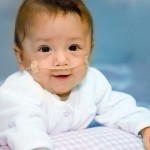So – this blog is the beginning of a rather excellent “Storify” summary of the March’s #ADC_JC which debated an RCT examining the use of heated humidified high-flow nasal cannula (HHHFNC) instead of hypertonic saline (HSS) in the management of bronchiolitis in the emergency department.
(For those who don’t know, Storify is a lovely way of capturing social media-based events and giving them a context and a thread … which the moderator of this journal club, @DrAlanGrayson has done beautifully.)
For the real experience, pop over to the full version, but whet your appetites here …
Bronchiolitis. The future?
This is the paper. Thanks to the usual excellent work behinds the scenes by the ADC elves (who I have never met, but I guess they are hard working editorial staff, run ragged by authors and reviewers (sorry, on behalf of us all for the tight deadlines ;-)) it was made open access with plenty of time for a somewhat lively crew to assemble.
Introduction
Welcome to the March iteration of #adc_jc After some great chat over the last two months, we’re back to RCTs
— ADC_JC (@ADC_JC) March 24, 2014
@ArchivesEandP @ADC_JC It’s a highly erudite & academic #adc_jc tonight then…
— CarmenSoto (@gourmetpenguin) March 24, 2014
This is either a welcome return to the important ground of “hard” science from the “fluffy” human factors and qualitative papers that we’ve covered recently or me taking the easy way out from the more difficult aspects of MedEd. I reckon there’s plenty of room within FOAM for both.
Bronchiolitis
For less-experienced readers, bronchiolitis is a viral illness, classically caused by Respiratory Syncytial Virus, occurring in the under-2 age group and in the winter months. The first “bronchy” cough of the year, usually in late September in the UK, is a clarion call to the children’s doctor and a reminder to order more caffeine – for the apnoeic kids and for the doc, as it may be a long winter of long shifts…

This beautiful illustration, from the wonderful site medical-artist.com, shows the bronchioles filling with mucus, which leads to difficulty in breathing.
Most kids are fine, but a significant proportion will need treatment in the PED, with a smaller admission rate. The authors suggest that, in those admitted, 10% of healthy children and ~36% of those with cardiorespiratory comorbidities will need PICU.

The chest sounds are distinctive; I was unable to find a sound file of stethoscopy, but this may help.
https://www.youtube.com/watch?v=RFwr_zbgJII
Treatment until recently has been supportive, with the sickest kids needing respiratory support, up to the level of intubation and ventilation and nutritional support (NG feeding and IVI).
Hypertonic saline solution (HSS) has been used in my PED for about 5 years. It’s mechanism is thought to be by osmosis, softening the mucus and allowing ciliary clearance.

Sorry the image is small. This link redirects to a useful article on HSS. Please note that HSS hasn’t been shown to reduce mortality or PICU admission, merely Length of Stay.
Bronchiolitis is arguably the most common significant medical illness of childhood. At least 1 in 7 normal infants will develop symptomatic bronchiolitis in his or her first year of life. 1 Hospitalization of infants for bronchiolitis is responsible for an annual expenditure of more than a half billion dollars.
The authors compare this with Hi-flow oxygen, delivering higher rates of humidified O2 than with standard nasal cannulae. They wished to prove the superiority of this therapy to HSS.+
Seems an interesting choice of an ‘either/or’ intervention to research. #adc_jc
— Henry Goldstein (@henrygoldstein) March 24, 2014
However, we weren’t convinced as there was some variation in the use of HSS by the group….
